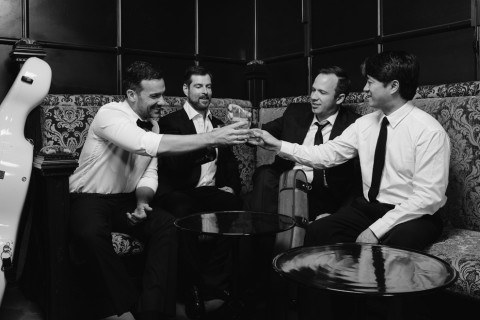

Press

REVIEWED BY ROBERT FAIRES, FRI., APRIL 10, 2015
Safe terrain is not where one expects to travel with the Miró Quartet. In the dozen years that it’s been quartet-in-residence at the University of Texas, this intrepid foursome has consistently taken routes that offer spectacular rewards but are not without risk. So last Friday evening, it was hardly a surprise to find myself with the ensemble on the side of a mountain, climbing to the summit on a winding road rife with treacherous switchbacks. At least that’s how it felt journeying through Schubert’s String Quartet No. 15 in G major, a work that revels in extremes. One moment the music is all anxious and fretful, the strings sawing away in jittery apprehension, the next it’s settled into a sedate amble, grounded by long, low tones from the cello. Then no sooner has the score calmed down than it works itself into another lather, all four bows fluttering like hummingbird heartbeats and signaling a skittish dread. So it went for the better part of an hour Friday, back and forth and back and forth between passages of easy lyricism and edgy unease, serene beauty and feverish tension – the musical equivalent of bipolar mood swings. To mine the intensity of feeling embedded in any one of the passages requires exceedingly expressive musicians, but to handle the constant shifting between emotional extremes – not to mention its coordination among four players – demands artists of uncommon skill and versatility. That’s what gives String Quartet 15 the feel of racing along a cliff’s edge, where a wrong move on any of those sharp curves could end in a precipitous drop.
But taking that precarious ride with the Miró was like being inside a perfectly tuned Porsche with an expert hand at the wheel: You barreled along with nary a bump, those hairpin turns handled so smoothly that you never felt the slightest whiplash from the abrupt changes of direction. And the quartet not only negotiated Schubert’s wildly disparate musical and emotional states with power and passion, they clearly relished doing so, as was evident in a moment when violinists Daniel Ching and William Fedkenheuer exchanged looks of mock surprise as the music suddenly changed course; as much as the work was demanding of them, the playfulness in their expressions revealed the joy they felt. And that joy transferred to the crowd, where it mingled with the amazement we felt at the command that Fedkenheuer, Ching, violist John Largess, and cellist Joshua Gindele had of this monumental material.
By comparison, the concert’s second work seemed rather straightforward. That’s not to say that Arnold Schöenberg’s Verklärte Nacht (Transfigured Night) is without deep feeling or its own potent emotional shifts. But this early composition (before Schöenberg’s experiments with atonality and the 12-tone system) follows the structure of the Richard Dehmel poem that inspired it: On a moonlit walk with her lover, a woman confesses that she’s pregnant and he is not the father, to which he responds with words of comfort and acceptance, and an embrace. So the music moves in a linear fashion from evocations of despair and guilt to expressions of solace and then to a sense of hope. The depth of feeling in each section had the lush, saturated colors of late Romanticism, with Schöenberg taking his cues from both Brahms and Wagner. It gave the Miró another opportunity to elicit strong emotions (and demonstrate its facility at doing so), but what made this piece special was the presence of two guest artists from Rice University: violist James Dunham and cellist Norman Fischer. The integration of these men into this fixed ensemble paid tribute to both the flexibility and collaborative spirit of all these musicians and the continuity in their craft – the knowledge and virtuosity passed from generation to generation. When the piece reached its open-hearted resolution, it seemed to belong to more than the poem’s two characters. It embraced everyone on that stage – and all the musicians who had taught them and all the musicians they would teach. It was a chord resonating across time, transfiguring much more than a single night.